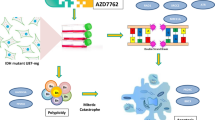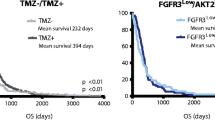Abstract
Purpose
Glioblastoma multiforme (GBM) is the most common malignant primary brain tumor in adults. While the alkylating agent temozolomide (TMZ) has prolonged overall survival, resistance evolution represents an important clinical problem. Therefore, we studied the effectiveness of radiotherapy and CCNU in an in vitro model of acquired TMZ resistance.
Methods
We studied the MGMT-methylated GBM cell line U251 and its in vitro derived TMZ-resistant subline, U251/TMZ-R. Cytotoxicity of TMZ, CCNU, and radiation was tested. Both cell lines were analyzed for MGMT promotor status and expression of mismatch repair genes (MMR). The influence of MMR inhibition by cadmium chloride (CdCl2) on the effects of both drugs was evaluated.
Results
During the resistance evolution process in vitro, U251/TMZ-R developed MMR deficiency, but MGMT status did not change. U251/TMZ-R cells were more resistant to TMZ than parental U251 cells (cell viability: 92.0% in U251/TMZ-R/69.2% in U251; p = 0.032) yet more sensitive to CCNU (56.4%/80.8%; p = 0.023). The effectiveness of radiotherapy was not reduced in the TMZ-resistant cell line. Combination of CCNU and TMZ showed promising results for both cell lines and overcame resistance. CdCl2-induced MMR deficiency increased cytotoxicity of CCNU.
Conclusion
Our results confirm MMR deficiency as a crucial process for resistance evolution to TMZ. MMR-deficient TMZ-resistant GBM cells were particularly sensitive to CCNU and to combined CCNU/TMZ. Effectiveness of radiotherapy was preserved in TMZ-resistant cells. Consequently, CCNU might be preferentially considered as a treatment option for recurrent MGMT-methylated GBM and may even be suitable for prevention of resistance evolution in primary treatment.






Similar content being viewed by others
Abbreviations
- 7AAD:
-
7-Amino-actinomycin D
- AxV:
-
Annexin V
- CCNU:
-
Lomustine
- CdCl2 :
-
Cadmiumchloride
- DMEM:
-
Dulbecco’s Modified Eagle Medium (Medium für Zellkultur)
- GBM:
-
Glioblastoma multiforme
- Gy:
-
Gray
- MD:
-
Mean difference
- MGMT:
-
O6-Methylguanin-DNA-methyltransferase
- MMR:
-
Mismatch-repair
- SF:
-
Survival fraction
- TMZ:
-
Temozolomide
References
Ostrom QT, Gittleman H, Liao P, Rouse C, Chen Y, Dowling J, et al. CBTRUS statistical report: primary brain and central nervous system tumors diagnosed in the United States in 2007–2011. Neuro-oncology. 2014;16(Suppl 4):iv1–63. doi:10.1093/neuonc/nou223.
Stupp R, Hegi ME, Mason WP, van den Bent MJ, Taphoorn MJ, Janzer RC, et al. Effects of radiotherapy with concomitant and adjuvant temozolomide versus radiotherapy alone on survival in glioblastoma in a randomised phase III study: 5-year analysis of the EORTC-NCIC trial. Lancet Oncol. 2009;10(5):459–66.
Fan TY, Wang H, Xiang P, Liu YW, Li HZ, Lei BX, et al. Inhibition of EZH2 reverses chemotherapeutic drug TMZ chemosensitivity in glioblastoma. Int J Clin Exp Pathol. 2014;7(10):6662–70.
Drablos F, Feyzi E, Aas PA, Vaagbo CB, Kavli B, Bratlie MS, et al. Alkylation damage in DNA and RNA–repair mechanisms and medical significance. DNA Repair. 2004;3(11):1389–407. doi:10.1016/j.dnarep.2004.05.004.
Fink D, Aebi S, Howell SB. The role of DNA mismatch repair in drug resistance. Clin Cancer Res. 1998;4(1):1–6.
Hegi ME, Diserens AC, Gorlia T, Hamou MF, de Tribolet N, Weller M, et al. MGMT gene silencing and benefit from temozolomide in glioblastoma. N Engl J Med. 2005;352(10):997–1003. doi:10.1056/NEJMoa043331.
Pegg AE. Repair of O(6)-alkylguanine by alkyltransferases. Mutat Res. 2000;462(2–3):83–100.
Sarkaria JN, Kitange GJ, James CD, Plummer R, Calvert H, Weller M, et al. Mechanisms of chemoresistance to alkylating agents in malignant glioma. Clin Cancer Res. 2008;14(10):2900–8. doi:10.1158/1078-0432.ccr-07-1719.
Liu L, Markowitz S, Gerson SL. Mismatch repair mutations override alkyltransferase in conferring resistance to temozolomide but not to 1,3-bis(2-chloroethyl)nitrosourea. Can Res. 1996;56(23):5375–9.
Felsberg J, Thon N, Eigenbrod S, Hentschel B, Sabel MC, Westphal M, et al. Promoter methylation and expression of MGMT and the DNA mismatch repair genes MLH1, MSH2, MSH6 and PMS2 in paired primary and recurrent glioblastomas. Int J Cancer Journal international du cancer. 2011;129(3):659–70. doi:10.1002/ijc.26083.
Cahill DP, Levine KK, Betensky RA, Codd PJ, Romany CA, Reavie LB, et al. Loss of the mismatch repair protein MSH6 in human glioblastomas is associated with tumor progression during temozolomide treatment. Clin Cancer Res. 2007;13(7):2038–45.
Shinsato Y, Furukawa T, Yunoue S, Yonezawa H, Minami K, Nishizawa Y, et al. Reduction of MLH1 and PMS2 confers temozolomide resistance and is associated with recurrence of glioblastoma. Oncotarget. 2013;4(12):2261–70.
Yip S, Miao J, Cahill DP, Iafrate AJ, Aldape K, Nutt CL, et al. MSH6 mutations arise in glioblastomas during temozolomide therapy and mediate temozolomide resistance. Clin Cancer Res. 2009;15(14):4622–9.
Messaoudi K, Clavreul A, Lagarce F. Toward an effective strategy in glioblastoma treatment. Part I: resistance mechanisms and strategies to overcome resistance of glioblastoma to temozolomide. Drug Discov Today. 2015;20(7):899–905. doi:10.1016/j.drudis.2015.02.011.
Batchelor TT, Mulholland P, Neyns B, Nabors LB, Campone M, Wick A, et al. Phase III randomized trial comparing the efficacy of cediranib as monotherapy, and in combination with lomustine, versus lomustine alone in patients with recurrent glioblastoma. J Clin Oncol. 2013;31(26):3212–8. doi:10.1200/jco.2012.47.2464.
Stupp R, Hegi ME, van den Bent MJ, Mason WP, Weller M, Mirimanoff RO, et al. Changing paradigms—an update on the multidisciplinary management of malignant glioma. Oncologist. 2006;11(2):165–80. doi:10.1634/theoncologist.11-2-165.
Aquilina G, Ceccotti S, Martinelli S, Hampson R, Bignami M. N-(2-chloroethyl)-N′-cyclohexyl-N-nitrosourea sensitivity in mismatch repair-defective human cells. Can Res. 1998;58(1):135–41.
Fiumicino S, Martinelli S, Colussi C, Aquilina G, Leonetti C, Crescenzi M, et al. Sensitivity to DNA cross-linking chemotherapeutic agents in mismatch repair-defective cells in vitro and in xenografts. Int J Cancer J Int Cancer. 2000;85(4):590–6.
Pepponi R, Marra G, Fuggetta MP, Falcinelli S, Pagani E, Bonmassar E, et al. The effect of O6-alkylguanine-DNA alkyltransferase and mismatch repair activities on the sensitivity of human melanoma cells to temozolomide, 1,3-bis(2-chloroethyl)1-nitrosourea, and cisplatin. J Pharmacol Exp Ther. 2003;304(2):661–8. doi:10.1124/jpet.102.043950.
Margison GP, Santibanez-Koref MF. O6-alkylguanine-DNA alkyltransferase: role in carcinogenesis and chemotherapy. BioEssays News Rev Mol Cell Dev Biol. 2002;24(3):255–66. doi:10.1002/bies.10063.
Glas M, Happold C, Rieger J, Wiewrodt D, Bahr O, Steinbach JP, et al. Long-term survival of patients with glioblastoma treated with radiotherapy and lomustine plus temozolomide. J Clin Oncol. 2009;27(8):1257–61. doi:10.1200/jco.2008.19.2195.
Herrlinger U, Rieger J, Koch D, Loeser S, Blaschke B, Kortmann RD, et al. Phase II trial of lomustine plus temozolomide chemotherapy in addition to radiotherapy in newly diagnosed glioblastoma: UKT-03. J Clin Oncol. 2006;24(27):4412–7. doi:10.1200/jco.2006.06.9104.
Yamauchi T, Ogawa M, Ueda T. Carmustine-resistant cancer cells are sensitized to temozolomide as a result of enhanced mismatch repair during the development of carmustine resistance. Mol Pharmacol. 2008;74(1):82–91.
Stupp R, Mason WP, Van Den Bent MJ, Weller M, Fisher B, Taphoorn MJ, et al. Radiotherapy plus concomitant and adjuvant temozolomide for glioblastoma. N Engl J Med. 2005;352(10):987–96.
Bedner E, Li X, Gorczyca W, Melamed MR, Darzynkiewicz Z. Analysis of apoptosis by laser scanning cytometry. Cytometry. 1999;35(3):181–95.
Darzynkiewicz Z, Juan G, Li X, Gorczyca W, Murakami T, Traganos F. Cytometry in cell necrobiology: analysis of apoptosis and accidental cell death (necrosis). Cytometry. 1997;27(1):1–20.
Schmid I, Krall WJ, Uittenbogaart CH, Braun J, Giorgi JV. Dead cell discrimination with 7-amino-actinomycin D in combination with dual color immunofluorescence in single laser flow cytometry. Cytometry. 1992;13(2):204–8. doi:10.1002/cyto.990130216.
Endt H, Sprung CN, Keller U, Gaipl U, Fietkau R, Distel LV. Detailed analysis of DNA repair and senescence marker kinetics over the life span of a human fibroblast cell line. J Gerontol Ser A Biol Sci Med Sci. 2011;66(4):367–75. doi:10.1093/gerona/glq197.
Hecht M, Harrer T, Buttner M, Schwegler M, Erber S, Fietkau R, et al. Cytotoxic effect of efavirenz is selective against cancer cells and associated with the cannabinoid system. Aids. 2013;27(13):2031–40. doi:10.1097/QAD.0b013e3283625444.
Sankar A, Thomas DG, Darling JL. Sensitivity of short-term cultures derived from human malignant glioma to the anti-cancer drug temozolomide. Anticancer Drugs. 1999;10(2):179–85.
Faoro D, von Bueren AO, Shalaby T, Sciuscio D, Hurlimann ML, Arnold L, et al. Expression of O(6)-methylguanine-DNA methyltransferase in childhood medulloblastoma. J Neurooncol. 2011;103(1):59–69. doi:10.1007/s11060-010-0366-7.
Jiricny J. The multifaceted mismatch-repair system. Nat Rev Mol Cell Biol. 2006;7(5):335–46. doi:10.1038/nrm1907.
Stark AM, Doukas A, Hugo H-H, Mehdorn HM. The expression of mismatch repair proteins MLH1, MSH2 and MSH6 correlates with the Ki67 proliferation index and survival in patients with recurrent glioblastoma. Neurol Res. 2010;32(8):816–20.
Jin YH, Clark AB, Slebos RJ, Al-Refai H, Taylor JA, Kunkel TA, et al. Cadmium is a mutagen that acts by inhibiting mismatch repair. Nat Genet. 2003;34(3):326–9.
Lützen A, Liberti SE, Rasmussen LJ. Cadmium inhibits human DNA mismatch repair in vivo. Biochem Biophys Res Commun. 2004;321(1):21–5.
Gallego O. Nonsurgical treatment of recurrent glioblastoma. Curr Oncol (Toronto, Ont). 2015;22(4):e273–81. doi:10.3747/co.22.2436.
Mizumoto M, Okumura T, Ishikawa E, Yamamoto T, Takano S, Matsumura A, et al. Reirradiation for recurrent malignant brain tumor with radiotherapy or proton beam therapy. Technical considerations based on experience at a single institution. Strahlentherapie und Onkologie: Organ der Deutschen Rontgengesellschaft [et al]. 2013;189(8):656–63. doi:10.1007/s00066-013-0390-6.
Berry SE, Kinsella TJ. Targeting DNA mismatch repair for radiosensitization. Semin Radiat Oncol. 2001;11(4):300–15.
Resnick KE, Frankel WL, Morrison CD, Fowler JM, Copeland LJ, Stephens J, et al. Mismatch repair status and outcomes after adjuvant therapy in patients with surgically staged endometrial cancer. Gynecol Oncol. 2010;117(2):234–8. doi:10.1016/j.ygyno.2009.12.028.
Acknowledgements
We would like to thank Mrs. Elisabeth Müller, Mrs. Doris Mehler, and Mrs. Renate Siebert for their technical expertise and help in conducting experiments. The present work was performed in fulfillment of the requirements for obtaining the degree “Dr. Med.”
Author information
Authors and Affiliations
Contributions
JS and FP performed the experiments mentioned in the “Materials and methods”, except for the pyrosequencing. RB performed pyrosequencing. JS, FP, LD were major contributors in writing the manuscript. RF provided materials and working space for the experiments we performed and revised the manuscript critically. All authors read and approved the final manuscript.
Corresponding author
Ethics declarations
Availability of data and materials
The datasets used and/or analyzed during the current study are available from the corresponding author on reasonable request.
Conflict of interest
The authors declare that they have no competing interests.
Funding
No funding was received.
Rights and permissions
About this article
Cite this article
Stritzelberger, J., Distel, L., Buslei, R. et al. Acquired temozolomide resistance in human glioblastoma cell line U251 is caused by mismatch repair deficiency and can be overcome by lomustine. Clin Transl Oncol 20, 508–516 (2018). https://doi.org/10.1007/s12094-017-1743-x
Received:
Accepted:
Published:
Issue Date:
DOI: https://doi.org/10.1007/s12094-017-1743-x




